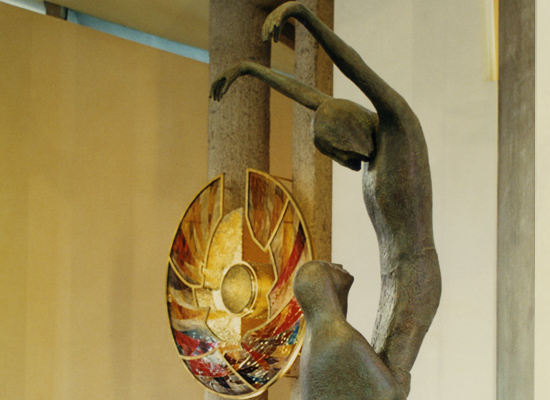
©Ave Cerquetti, ‘L’unico Bene’ – Mariapolis Ginetta (Brazil) 1998
interconnected through “the irreversible encounters between peoples and civilisations the world over, that had been made possible through a veritable explosion of means of communication and massive technological development”. While highlighting the positive in all this,
Chiara Lubich warned those young people that “today not everyone is well prepared for this encounter”, which was often destabilising because people realised their way of thinking was not the only one. She invited the young people not to confuse absolute values, those linked to what is Eternal, with their own mental structures. As people’s certainties were shattered, Chiara offered them a model to follow, a key that would open the doors to building a new world. “We may wonder how to live in this terrible present day when a mysterious earthquake seems to shake-up the noblest of values, like enormous skyscrapers that crumble and crash into one another. Is there a practical answer …, a sure means we can rely on so as to contribute to generating the world of the future? “Is there a type of global-person who has felt within them this terrible earthquake which threatens to destroy everything that was thought untouchable up to now? Is there someone who almost believed that absolute truth itself was leaving him to his own destiny, throwing him into the greatest confusion? Is there a global person who was able to overcome this terrible trial, paying for a new world which he found anew within himself and which he generated for others? Yes, such a person exists. But it is easy to understand this person couldn’t be merely a human being, but had to be
the Human being: it’s Jesus forsaken. “His humanity, which was perfect, yet weak and subject to suffering and death, is the symbol of every human structure, which, within its limits has been able, throughout the centuries, to give humankind something unlimited, such as the truth.
“On the cross, close to his physical death, and to his abandonment, which was his mystical death, Jesus experienced the destruction of all his humanity, of his being man; of his bodily structure, so to speak. At that moment, the Father mysteriously allowed that Jesus doubted even God’s presence within him, as though it had vanished.
This is why he cried out, “My God, my God why have you forsaken me?” (Mt 27:46). “But since he is God, precisely in this cry, Jesus had the strength to overcome this infinite suffering. By so doing He gave his weak, mortal flesh the power of immortality, bringing his risen body into the heart of the immortal Trinity. Moreover, with this extraordinary act of accepting the most frightening destruction ever known to heaven or on earth,
Jesus gave humankind the possibility of rising again in the next life, with the resurrection of the body, and rising again in this life with a spiritual resurrection – when we love Jesus Forsaken – from any death or destruction in which people might find themselves. “Jesus Forsaken … is the reliable leader for all young people in this century. When he is loved he offers those who follow him the spirit of truth, in the same way as he made the Holy Spirit descend upon the apostles after his death.” Chiara affirmed that “by following him they will find the strength not to fear any situation, but to face it with confidence. It is a confidence which knows that every human truth and the Truth itself, which is the Kingdom of Heaven, can find, also with their help, new mental structures on a worldwide level.” And she ended: “It is up to you to welcome him into your hearts like the most precious pearl that you can receive; for your spiritual life, for the peoples you represent here; but above all for that new world which must see all people united; for the new world which will be home not only to many peoples, but to the people of God”. Source:
Chiara Lubich, Colloqui con i gen 1970-74, Citta’ Nuova, ed, 1999, pp 73-83.
0 Comments